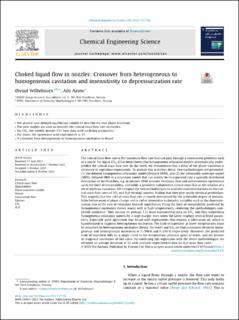| dc.description.abstract | The critical mass flow rate is the maximum flow rate that can pass through a constrained geometry such as a nozzle. For liquid CO2, it has been shown that homogeneous relaxation models systematically underpredict the critical mass flow rate. In this work, we demonstrate that a delay of the phase transition is necessary to reproduce experiments. To analyze this in further detail, two methodologies are presented: (1) the delayed homogeneous relaxation model (Delayed HRM), and (2) the metastable isentrope model (MIM). Delayed HRM is a relaxation model that can readily be incorporated into a spatially distributed description of the fluid flow, e.g. in ejectors. MIM assumes isentropic flow and instantaneous equilibrium up to the limit of metastability, and yields a geometry-independent critical mass flux as the solution of a set of algebraic equations. We compare the two methodologies to available experimental data on the critical mass flow rates of CO2 and H2O through nozzles, finding that they give nearly identical predictions. This suggests that the critical mass flow rate is mostly determined by the achievable degree of metastability before onset of phase change, and is rather insensitive to dynamic variables such as the depressurization rate or the rate of relaxation towards equilibrium. Using the limit of metastability predicted by homogeneous nucleation theory works well at high temperatures, rendering the methodologies completely predictive. They deviate on average 11% from experimental data on CO2, and thus outperform homogeneous relaxation models by a large margin, even when the latter employs several fitted parameters. Especially good agreement was found with experiments that employ a lubrication oil, which is hypothesized to suppress heterogeneous nucleation. The limit of superheat at lower temperatures must be described by heterogeneous nucleation theory. For water and CO2 we find a crossover between homogeneous and heterogeneous nucleation at T590 K and T285 K respectively. Moreover, the predicted limit of superheat falls on a single curve in the temperature–pressure space of water, and we present an empirical correlation of this curve. By combining this expression with the above methodologies, we obtained an average deviation of 3% with available experimental data on H2O mass flow rates. | en_US |

